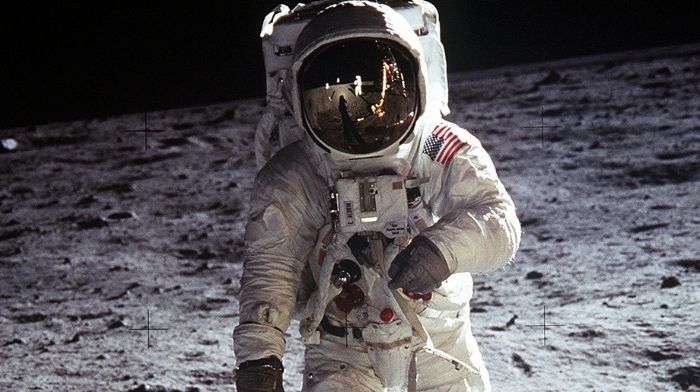
By Robert Charles for RealClearPolitics
Rare is the chance to talk introspectively with an Apollo astronaut. Rarer still, Apollo 11’s Buzz Aldrin.
July 20 is the 52nd anniversary of his epic moon landing. Neil Armstrong died nine years ago, Mike Collins this year. But Buzz Aldrin is crisp and confident.
In a recent interview, he looked back on the mission. At age 91, Edwin Eugene Aldrin remains focused on the future, reflective, and hopeful. He is both a storyteller and stoic.
Asked about the lead-up to the Apollo mission, he recalls intensive training, time flying fighter jets in Korea, Gemini 12. Interestingly, his blood pressure during Gemini 12 spacewalks in 1966 was very low.
Why? He laughs, saying the excursions were fun. One gets the impression that, against the odds, he cloaks a bit of whimsy.
RELATED: The Significance Of The ‘Shot Heard Round the World’
Preparing for mankind’s first moon landing on July 20, 1969, the three crewmates trained incessantly until launch. What was it like atop the Saturn V, at 36 stories high — bigger than the Statute of Liberty and Big Ben — the largest rocket every built?
Aldrin is frank. “Well, it was exciting. … As countdown proceeded, we were glad we didn’t have to start over.” He added, “Launch went very smoothly … nothing unexpected” and he, Armstrong and Collins “did not know exactly when we had left the ground, except from the instruments we were watching and voice communications.”
He notes that, “from the instruments, we could see our rate of climb and altitude changing, but we were comfortable in our seats.” What did they think in that moment? “We sort of looked at each other and thought we must be on our way … so what’s next?”
Excitement came soon enough. In lunar orbit, Collins flew the Columbia command module as Armstrong and Aldrin headed for the moon in their leggy lunar module.
The walls of the LEM were three times the thickness of aluminum foil, as weight mattered and aerodynamics did not without atmosphere.
During the descent, he and Armstrong constantly adjusted, first to high horizontal speed, then managing alarms signaling computer overload. (Current smartphones have a million times more power than Apollo’s guidance computers.) Aldrin knew they were getting low on fuel, and heard the 30-second warning.
He called coordinates forward and down as Armstrong averted boulders, landing in the Sea of Tranquility on fumes. They were relieved to be down, as was half the world listening from a quarter-million miles away.
Asked whether he thought much about home while on the moon, Aldrin says not really — they were busy doing jobs. “While others thought about what we were doing, we were very concentrated on being on the moon.”
Later, he notes, whimsically again, the Apollo 11 crew missed “the big event” as hundreds of millions of people watched them walk on the lunar surface and return to Earth days later.
Armstrong famously said, after stepping off the ladder, this was “one small step for man, one giant leap for mankind.” Buzz spoke of “magnificent desolation.” As for his audience when uttering those words, “We really did not think much about that. … We were focused on mission control; they were the people we had to think about most.”
He describes putting out experiments, coordinating tasks, the relative ease of movement, time required to secure the American flag, and proudly saluting the flag.
I am reminded of a display at the National Air & Space Museum in Washington, D.C., of spacesuits worn by Apollo and Soviet astronauts. The former suit has moon dust on the knees. Soviets never sent men to our orbiting neighbor.
Aldrin, who holds a PhD in astronautical engineering from MIT, is remarkably candid. So much did the crew study maps that, in many ways, close-up views of the surface were more “the moon” to them than the glowing orb the rest of us see in the night sky.
Tasks were performed as trained, then back in the lunar module.
RELATED: ‘Climate Change’ Policy Is A Money-Making Opportunity For The Elite
One near miss, or minor miracle, was that a push-in/push-out circuit breaker controlling the LEM’s ascent engine “snapped off” as the two reentered, requiring some thought. Mission control instructed them to sleep, which they did, as a solution was pondered back on Earth.
Next morning, no solution. So, rather resourcefully, Aldrin deployed a felt-tip pen to push the switch in, which got them off the surface. American ingenuity.
On July 24, reentry was smooth, three parachutes deployed, but their capsule flipped over in the water before they could release the ’chutes and inflate balloons that up-righted Columbia. To avoid possible contamination by potential moon bacteria, they donned containment gear and then quarantined for 21 days.
“We certainly were glad to be back home,” Aldrin noted, and “even this many years later, it was a privilege to have been on that first manned mission to the lunar surface, an honor to have worked with so many good and dedicated people, and to have left our footprints there.”
In closing, he says he “marvels” at it all and that “it is time for the next generation to set their eyes on Mars.”
Crisp and confident, Buzz Aldrin inspires.
Syndicated with permission from RealClearWire.
